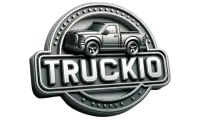Learn the art of creating your own tonneau cover with our comprehensive guide.
From gathering materials to testing the fit, explore step-by-step instructions for crafting a tonneau cover tailored to your truck.
Discover cost-effective options, factors to consider, and FAQs to help you succeed in your DIY endeavor.
Get ready to enhance your truck’s functionality and style with a customized tonneau cover you made yourself.
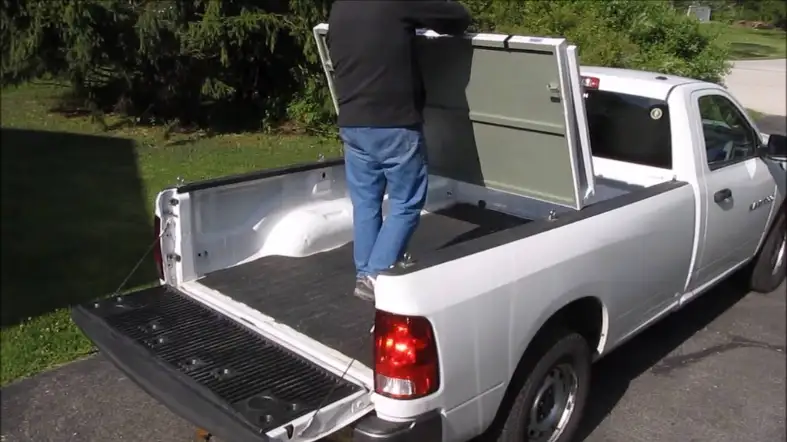
How To Make A Tonneau Cover
Gather the necessary materials
To make your own tonneau cover, you will need the following materials: a durable fabric (such as vinyl or canvas), a measuring tape, scissors, a sewing machine (or needle and thread if hand-sewing), sturdy adhesive or Velcro strips, a ruler, and a pen or marker.
Measure and cut the fabric
Using the measuring tape, measure the dimensions of your truck bed. Ensure you measure both the length and width accurately.
Add a few inches to the measurements to allow for proper fitting and adjustments.
Next, using the measurements you obtained, mark and cut the fabric with scissors. Be precise and ensure the fabric is cut straight.
Sew the edges
To prevent fraying and give the tonneau cover a polished look, sew the edges of the fabric.
If you’re using a sewing machine, set it to a zigzag stitch to reinforce the edges.
If hand-sewing, use a backstitch to secure the threads. Take your time and ensure the stitches are tight and secure along the entire length of the fabric.
Reinforce the corners
The corners of your tonneau cover will experience the most tension, so reinforcing them is crucial.
Fold each corner of the fabric about 2 inches inward and sew them together with a straight stitch. This reinforcement will add strength and durability to your cover.
Attach the securing mechanism
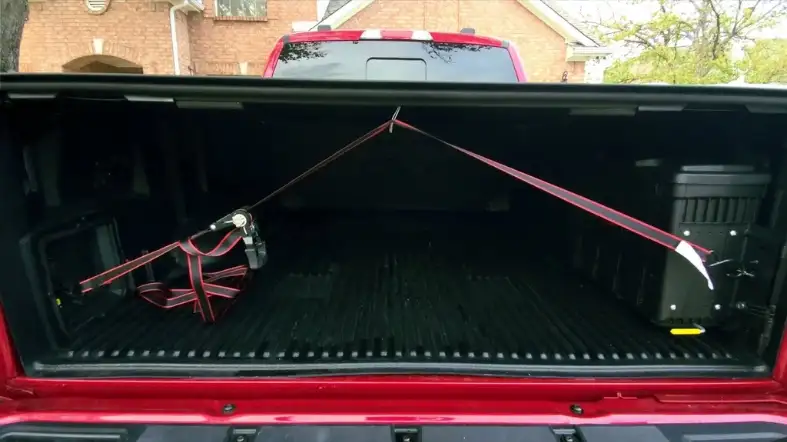
There are various methods to secure the tonneau cover to your truck bed. One common approach is to use adhesive or Velcro strips.
Measure and cut the strips to fit along the edges of the fabric and the corresponding areas of your truck bed.
Apply the adhesive or stick the Velcro strips to the fabric and truck bed, ensuring they align properly. Press firmly to ensure a strong bond.
Test the fit and make adjustments
With the securing mechanism in place, carefully position the tonneau cover over your truck bed. Ensure it fits snugly and covers the entire bed area.
Make any necessary adjustments to the securing mechanism or fabric as needed.
Double-check the alignment and fit, ensuring the cover is taut and properly attached.
Test for water resistance
One important aspect of a tonneau cover is its ability to protect your truck bed from water.
To test for water resistance, spray water over the cover using a hose or a bucket.
Observe if any water seeps through the fabric or the edges. If you notice any leaks, make the necessary adjustments or consider adding additional weatherproofing measures, such as sealing the seams or applying a water-resistant coating.
Maintain and clean the tonneau cover
To ensure the longevity of your tonneau cover, it’s essential to maintain and clean it regularly.
Follow the manufacturer’s instructions for cleaning the specific fabric you used.
A mixture of mild soap and water should suffice for routine cleaning. Avoid using harsh chemicals or abrasive materials that could damage the fabric.
Regular maintenance will keep your tonneau cover looking great and functioning effectively.
How To Make A Fiberglass Tonneau Cover
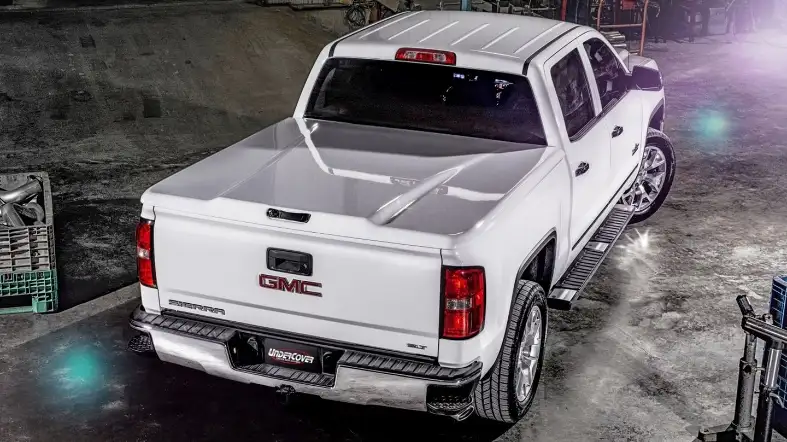
Estimate the Costing To Make A Fiberglass Tonneau Cover :
The cost of making a fiberglass tonneau cover will vary depending on the materials used and their availability.
Fiberglass sheets can range from $50 to $200, while resin and catalysts can cost around $30 to $50.
Additional materials like reinforcement materials, release agents, and tools may add to the overall cost.
Planning and Measuring Your Truck Bed
- Assess the dimensions and shape of your truck bed.
- Determine the specific requirements for your tonneau cover.
- Take precise measurements to ensure a proper fit.
Gathering Materials and Tools
- Acquire the necessary materials, including fiberglass cloth, resin, hardener, and release agent.
- Gather tools such as a roller, paintbrush, mixing container, gloves, and safety equipment.
Designing the Tonneau Cover
In this step, you’ll determine the shape and style of your tonneau cover.
Sketch out your design on paper, taking into account any specific requirements or preferences you have.
Consider factors such as access to the truck bed, aerodynamics, and overall aesthetics.
Building a Mold
- Create a mold for the tonneau cover using plywood or another suitable material.
- Shape the mold according to the measurements and desired design.
- Apply a release agent to the mold to prevent sticking.
Preparing and Applying the Fiberglass
- Cut the fiberglass cloth into manageable pieces.
- Mix the resin and hardener according to the manufacturer’s instructions.
- Apply a layer of resin to the mold using a paintbrush or roller.
- Place the fiberglass cloth on top of the wet resin, ensuring even coverage.
- Apply additional layers of resin and fiberglass, allowing each layer to cure before adding the next.
Shaping and Trimming the Cover
- Once the fiberglass has cured, remove it from the mold carefully.
- Trim excess material and shape the cover to fit your truck bed.
- Use sandpaper or a grinder to smooth the edges and create a finished look.
Installing the Tonneau Cover
- Test the fit of the fiberglass tonneau cover on your truck bed.
- Attach hinges, latches, or other hardware as required.
- Install any additional components, such as support struts or weatherstripping.
Finishing Touches and Customization
- Apply a primer and paint to the fiberglass tonneau cover for a polished appearance.
- Consider adding accessories like locks, gas struts, or a spoiler for enhanced functionality and style.
- Apply a protective clear coat or gel coat to ensure durability and resistance to UV rays.
How To Make A Hard Tonneau Cover
Gathering Materials and Tools
To begin, you’ll need to gather the necessary materials and tools. Here’s what you’ll need:
Materials:
- Plywood or another sturdy material for the cover
- Hinges
- Latches or locks
- Weatherstripping
- Foam padding (optional for added protection)
- Screws
- Sandpaper
- Primer
- Paint or sealant
Tools:
- Tape measure
- Saw (circular saw or jigsaw)
- Drill
- Screwdriver
- Paintbrush or roller
Taking Measurements
The first step is to measure your truck bed accurately. Measure the length, width, and height of the bed.
Make sure to take into account any protrusions or obstructions such as bed rails or toolboxes.
These measurements will serve as the basis for constructing your tonneau cover.
Designing and Cutting the Cover
Using the measurements you took in the previous step, mark and cut the plywood or other sturdy material accordingly.
A circular saw or jigsaw works well for this task. Remember to be precise and double-check your measurements to ensure a proper fit.
Sanding and Finishing
Smooth out the edges of the cut plywood using sandpaper. This step will give your tonneau cover a professional and polished look.
Additionally, consider applying a coat of primer to protect the wood and enhance the durability of your cover.
Attaching Hinges and Latches
Next, attach hinges to one side of the tonneau cover and the corresponding area of the truck bed.
Ensure the hinges are properly aligned and securely fastened. This will allow the cover to open and close smoothly.
Additionally, install latches or locks on the opposite side to keep the cover securely closed.
Applying Weatherstripping
To prevent water and dust from seeping into your truck bed, apply weatherstripping along the edges of the tonneau cover.
This will create a tight seal when the cover is closed, keeping your cargo protected.
Adding Foam Padding (Optional)
If you want to provide extra cushioning and protection for your cargo, consider adding foam padding to the underside of the tonneau cover.
This will help prevent any damage to fragile items during transportation.
Painting or Sealing
To enhance the aesthetics and protect the tonneau cover from the elements, paint or seal it.
Choose a paint or sealant that is suitable for outdoor use and compatible with the material you used. Apply multiple coats for optimal durability and longevity.
Costing Details
Now, let’s discuss the costing details for making a hard tonneau cover.
The cost will depend on various factors, such as the size of your truck bed, the materials you choose, and any additional features you decide to incorporate.
Here’s a breakdown of the approximate costs:
- Plywood or other sturdy material: $50 – $100
- Hinges: $10 – $20
- Latches or locks: $10 – $30
- Weatherstripping: $10 – $20
- Foam padding (optional): $10 – $30
- Screws, sandpaper, primer, paint, or sealant: $20 – $50
Note:
Keep in mind that these prices are estimates and can vary depending on your location and the specific products.
Factors to Consider When Making a DIY Tonneau Cover
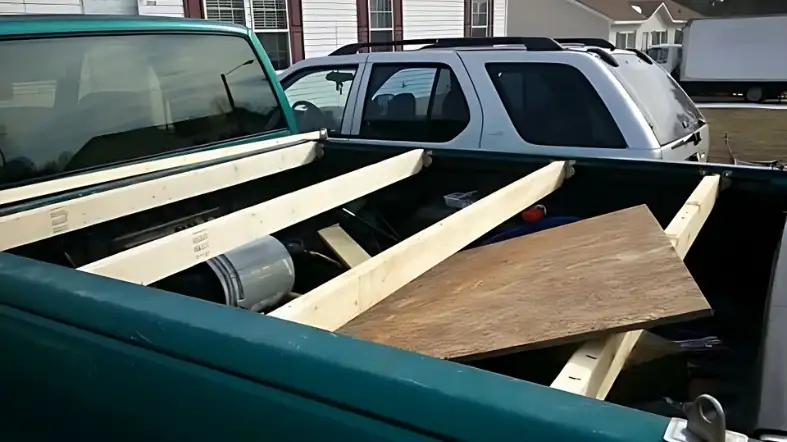
Material Selection
Selecting the right material is crucial for the durability and functionality of your DIY tonneau cover.
You have several options, including vinyl, canvas, aluminum, and fiberglass.
Each material has its own pros and cons. Vinyl and canvas are lightweight, affordable, and relatively easy to work with, but they may not provide the same level of security and weather resistance as aluminum or fiberglass.
On the other hand, aluminum and fiberglass offer superior strength and weatherproofing, but they can be more expensive and require specialized tools for installation.
Design and Style
Consider the design and style of your tonneau cover to ensure it complements your truck’s overall aesthetics.
You can opt for a one-piece cover that provides a seamless look or a multi-panel design that allows for easy access to specific areas of your truck bed.
Additionally, think about whether you want a hard cover that provides enhanced security or a soft cover that offers flexibility and easy installation.
Mounting Mechanism
Decide on the mounting mechanism that best suits your needs and preferences.
Common options include snap-on covers that attach to the bed rails, roll-up covers that utilize Velcro or hook-and-loop fasteners, or retractable covers that slide into a canister near the cab.
Each mechanism has its own advantages and disadvantages in terms of security, ease of use, and access to the truck bed.
Weather Resistance
Consider the weather conditions in your area and how well your tonneau cover needs to withstand them.
If you frequently experience heavy rain or snow, you’ll want a cover that provides excellent water resistance to protect your cargo.
Look for features such as reinforced seams, weather seals, and drain tubes to ensure proper water drainage and prevent leaks.
Security Features
Evaluate the level of security you require for your truck bed. A tonneau cover can act as a deterrent against theft and keep your belongings safe.
Look for covers with built-in locks or options to add a separate locking mechanism.
Additionally, consider covers with integrated tailgate locks or compatibility with your existing tailgate lock to ensure comprehensive security.
Installation and Maintenance
Consider the installation process and maintenance requirements of your DIY tonneau cover.
Look for covers that come with detailed instructions and all the necessary hardware for a straightforward installation.
Additionally, think about how easy it will be to clean and maintain the cover over time.
Some materials may require regular cleaning and conditioning to maintain their appearance and functionality.
4 Cheap Alternatives to Tonneau Cover
1. Tarp
If you’re on a tight budget, a tarp can be a quick and inexpensive solution for covering your truck bed.
Available at hardware stores for less than $10, tarps are made from materials like polyethylene or canvas, which offer varying degrees of waterproofing and durability.
While they may not provide the same level of protection as a tonneau cover, they can shield your truck bed from rain, snow, and debris to some extent.
Tarps are easy to find and simple to install. You can secure them using bungee cords, ropes, or tie-down straps, and adjust or remove them as needed.
However, it’s important to keep in mind that tarps may not fit your truck bed perfectly, leaving certain areas exposed.
Additionally, their durability may be lower than that of specialized truck bed covers.
2. Rubber bed mat
A rubber bed mat is an affordable option that helps safeguard your truck bed against dirt, scratches, and general wear and tear.
Typically made from heavy-duty rubber, these mats are designed to fit the contours of your specific truck bed.
They offer a non-slip surface, preventing items from sliding around while you’re driving.
Installing a rubber bed mat is a breeze. Most mats come pre-cut to match your truck bed’s dimensions, so you simply lay them down.
Some mats may require additional fasteners or adhesive strips to ensure a secure fit. Cleaning a rubber bed mat is also straightforward – a quick hose-down or pressure wash will usually do the trick.
3. Bed extender
If you frequently need to transport long items that extend beyond your truck bed, a bed extender can be a cost-effective solution.
This accessory attaches to the rear of your truck bed and extends its length, providing the extra space required for carrying items such as lumber, pipes, or even kayaks.
Bed extenders are typically constructed from metal and offer adjustable length settings to accommodate different cargo sizes.
Installing a bed extender usually involves connecting it to the hitch receiver of your truck.
Once attached, you can easily flip it outward to create the necessary extension for your cargo. Bed extenders are lightweight and can often be stored in the truck bed when not in use.
4. Truck bed canopy
A truck bed canopy, also referred to as a truck cap or camper shell, is a more expensive alternative to tonneau covers.
However, it provides numerous benefits for truck owners. Canopies are custom-designed to fit specific truck models and are commonly made of fiberglass or aluminum.
They enclose the entire truck bed, offering protection from the elements, enhanced security, and increased privacy.
Truck bed canopies create a separate covered space in the back of your truck, shielding your cargo from weather conditions and potential theft.
They are particularly useful for transporting valuable or fragile items that require extra care.
Canopies also serve as secure storage areas for tools, equipment, or camping gear.
Depending on the model, they may include features such as windows, roof racks, or interior lighting.
Installing a truck bed canopy typically requires professional installation or careful do-it-yourself work.
The process involves attaching the canopy to the truck bed rails and ensuring a proper fit.
Canopies come in various styles, such as cab-high and high-rise options, providing different levels of storage and headroom.
While they may be pricier than other alternatives, truck bed canopies offer a comprehensive solution for those seeking increased protection, security, and storage capabilities.
FAQs
Do I Need Any Special Tools To Make A Tonneau Cover?
Basic sewing tools such as a sewing machine, scissors, measuring tape, and thread are typically needed.
Can I Customize The Size Of My Tonneau Cover?
Yes, you can customize the size of your tonneau cover by measuring your truck bed and cutting the material accordingly.
Will Making A Tonneau Cover Require Any Sewing Skills?
Basic sewing skills are helpful, but there are simpler DIY options available that may not require extensive sewing.
Are There Any Specific Instructions For Installing Support Bars Or A Frame?
Installation instructions may vary depending on the design, but typically, support bars or a frame can be attached securely to the truck bed.
Can I Make Adjustments To The Tonneau Cover If It Doesn’t Fit Perfectly?
Yes, you can make adjustments by altering the dimensions, adding or removing fasteners, or modifying the support system to ensure a proper fit.
Final Words
Now that you know the ins and outs of making a tonneau cover, you’re equipped with the knowledge to protect your truck bed in style.
With durable materials and basic sewing skills, you can customize the size, securely fasten it, and even add support bars or a frame.
Don’t wait any longer – unleash your creativity and craft a personalized tonneau cover that suits your needs perfectly. Get ready to hit the road with confidence and keep your cargo safe and secure.
